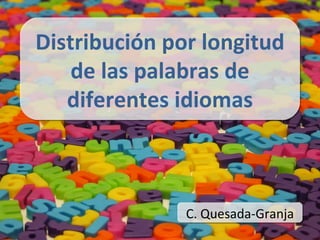
Distribución por longitud de las palabras de diferentes idiomas
- 1. Distribución por longitud de las palabras de diferentes idiomas C. Quesada-Granja
- 3. Muchos fenómenos se pueden caracterizar mediante distribuciones de probabilidad
- 4. La distribución de las palabras según su número de letras ¿sigue algún modelo estadístico?
- 5. Es decir…
- 6. Si tomamos un texto y contamos… • las palabras de 1 letra, • las palabras de 2 letras, • las palabras de 3 letras, • las palabras de 4 letras, • las palabras de 5 letras, • las palabras de 6 letras,
- 7. … y representamos el resultado en un histograma… 300 250 Número de palabras 200 150 100 50 0 0 5 10 15 20 25 Número de letras
- 8. … ¿se parecerá a alguna distribución de probabilidad conocida?
- 10. Selección de los textos Carácter enciclopédico Para una docena de lenguas con alfabeto latino Un fichero por cada lengua
- 11. Contenido de los ficheros 2.500 palabras Fragmentos de artículos destacados de Wikipedia 10 ó 12 artículos con temáticas diferentes, extraídos al azar
- 12. Análisis de los ficheros Programa en Matlab Procesa los ficheros Representa resultados mediante histogramas
- 13. function datos = leer(namefile) texto = textread(namefile, '%s'); numpal = size(texto); vectL = zeros(1,numpal(1)); for i = 1:numpal vectL(i) = length(char(texto(i))); end hist(vectL, 1:max(vectL))
- 14. Resultados
- 15. La distribución de las palabras no es igual para todas las lenguas Similitudes cuando se agrupan por familias lingüísticas
- 16. Lenguas romances
- 17. 700 700 600 ESPAÑOL 600 FRANCÉS μ = 4,9380 μ = 4,8667 Número de palabras Número de palabras 500 500 400 σ = 3,0571 400 σ = 3,0697 300 300 200 200 100 100 0 0 0 2 4 6 8 10 12 14 16 18 0 2 4 6 8 10 12 14 16 18 Número de letras Número de letras 600 600 500 CATALÁN 500 μ = 4,7331 Número de palabras Número de palabras 400 400 σ = 3,0985 300 300 200 200 100 100 0 0 1 2 3 4 5 6 7 8 9 10 11 12 13 14 15 0 5 10 15 Número de letras Número de letras
- 18. Lenguas germánicas occidentales
- 19. 600 600 500 INGLÉS 500 NEERLANDÉS μ = 4,8773 μ = 5,2007 Número de palabras Número de palabras 400 400 σ = 2,6171 σ = 3,0556 300 300 200 200 100 100 0 0 0 2 4 6 8 10 12 14 16 18 0 5 10 15 20 25 Número de letras Número de letras 700 600 600 ALEMÁN 500 μ = 6,0968 Número de palabras Número de palabras 500 400 400 σ = 3,6668 300 300 200 200 100 100 0 0 0 5 10 15 20 25 30 0 2 4 6 8 10 12 14 16 18 20 Número de letras Número de letras
- 20. Lenguas eslavas occidentales
- 21. 350 350 300 POLACO 300 CHECO μ = 5,6452 μ = 5,3604 Número de palabras Número de palabras 250 250 200 σ = 3,3431 200 σ = 2,9859 150 150 100 100 50 50 0 0 0 5 10 15 20 25 0 2 4 6 8 10 12 14 16 18 Número de letras Número de letras 350 300 300 ESLOVACO 250 μ = 5,6638 Número de palabras Número de palabras 250 200 200 σ = 3,2797 150 150 100 100 50 50 0 0 0 2 4 6 8 10 12 14 16 18 20 0 2 4 6 8 10 12 14 16 18 Número de letras Número de letras
- 22. Lenguas de otras familias
- 23. 350 350 300 EUSKERA 300 FINÉS μ = 6,5018 μ = 7,8866 Número de palabras Número de palabras 250 250 200 σ = 2,8321 200 σ = 3,8362 150 150 100 100 50 50 0 0 0 2 4 6 8 10 12 14 16 18 20 0 5 10 15 20 25 30 Número de letras Número de letras 300 400 250 HÚNGARO 350 ISLANDÉS μ = 6,2615 μ = 5,2470 Número de palabras 300 Número de palabras 200 σ = 3,6546 250 σ = 3,1405 150 200 150 100 100 50 50 0 0 0 5 10 15 20 25 0 5 10 15 20 25 30 35 Número de letras Número de letras
- 25. No se puede establecer un modelo estadístico común a todas las lenguas Las lenguas de las mismas familias lingüísticas presentan características similares
- 26. Posibles aplicaciones Diseño de algoritmos para la detección automática de lenguas Estudios de eficiencia
- 27. Longitudes medias (*) FINÉS 7,89 EUSKERA 6,50 HÚNGARO 6,26 ALEMÁN 6,10 5,92 ESLOVACO 5,66 POLACO 5,65 CHECO 5,36 ISLANDÉS 5,25 NEERLANDÉS 5,20 ESPAÑOL 4,94 4,96 INGLÉS 4,88 4,50 FRANCÉS 4,87 4,84 CATALÁN 4,73 (*) Fletcher Pratt, Secret and Urgent: the Story of Codes and Ciphers, Blue Ribbon Books, 1939, pp. 256-257.
- 28. C. Quesada-Granja quesadagranja@gmail.com CC-BY: Gaetan Lee CC-BY: tj scenes